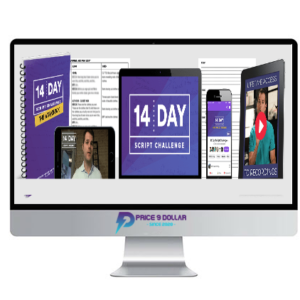Bob Serling – The Marketing Ladder Blueprint
$497.00 $9.00
Total Sold: 7
Sale Page: http://www.profitalchemy.com/mlbc/
Bob Serling – The Marketing Ladder Blueprint Contains: PDF´s, Audio
Description
Bob Serling – The Marketing Ladder Blueprint
The Marketing Ladder Blueprint
How to put an end to marketing chaos… generate a small but highly responsive list of paying customers only… and consistently grow your profits and your business by actually doing much less marketing.
6 Steps for creating your Marketing Ladder System to build a small but highly responsive list of actual buyers and make continuing, repeat sales to them
Fortunately, eliminating your ineffective, damaging Marketing Funnel and replacing it with a high-performing Marketing Ladder is reasonably easy.
Once you do this, instead of 98% of your list being made up of freebie grabbing prospects and just 2% being customers, we’ll reverse those numbers almost completely. By implementing The Marketing Ladder, your list will be much smaller, but it will consist of 90% paying customers and just 10% prospects who have accepted something for free in exchange for opting into your list. And all it takes to do this are two things:
- 1. Understanding how to create a Marketing Ladder System and fully capitalize on it
- 2. Committing to implementing it
I can clearly show and guide you through the reasonably simple steps of building your Marketing Ladder System. What you’ll need to bring to the table is the commitment to carry out the implementation. With this in mind, let’s take a tour of the 6 steps for creating your Marketing Ladder System.
MLB Step 1: Create an extremely compelling “bait piece”
The core principle that drives the Marketing Ladder is just the opposite of the traditional marketing funnel. Instead of building a massive list of tire kickers (at a tremendous cost of time and money), you build a much smaller list that’s primarily paying customers.
However, similar to the old marketing funnel method, in order to attract prospects’ attention, you must entice them to opt-in to your list by creating an extremely compelling “bait piece” to be given away for free. What?
Didn’t I just build a case for not giving things away for free — and charging for them instead?
Absolutely.
But while the goal is to deal only with customers who have bought something from you, because of the current state of the market, you still have to give something away for free in order to reach this goal.
Ideally, I’d like to be able to start with each prospect buying something instead of getting something for free. But I’m not foolish enough to make this such a steep uphill climb that it ends up failing. So because people are so conditioned to join your list by getting something for free, that will still be your starting point.
However, the sources you use to drive traffic and add people to your list are extremely different, which is exactly what you do in the next step.
MLB Step 2: Find only those prospects who are highly likely to make a small purchase immediately and offer your bait piece to them
In this Step, things begin to get radically different — and radically better. You’re still going to use your bait piece as the primary way of attracting prospects to opt-in to your list. And you’re still going to offer it for free.
But the critical difference is that you apply much more careful and effective targeting to do the best job possible of identifying only those prospects who are highly likely to make a small purchase immediately. These are the only people who you’ll offer your free bait piece to.
This is achieved by eliminating all of the wasteful media and marketing tactics you’re currently using and replacing them with just three prospecting sources:
- Rented email lists consisting only of buyers (magazine subscribers, association members and buyers of products or services similar to yours)
- Stand-alone emails to other businesses’ lists — preferably their buyers only
- List swaps (having another list owner promote your bait piece to their list in exchange for you promoting theirs)
The key similarity between these sources is that the majority of the time, you can use them to reach people who have already demonstrated a willingness to buy.
With other sources, such as social media, pay-per-click, article marketing, video marketing, banner ads and so on, you don’t have any idea whether the prospect has ever bought anything similar to what you offer. So those prospects are far less likely to buy the low-cost item you offer than prospects with a proven buying history.
Just by shifting to this method of prospecting alone, you’ll eliminate nearly all the chaos normally associated with marketing. So you’ll be able to dramatically reduce the time and money you invest in marketing, freeing up your time to focus on other important aspects of running your business.
What this means is that right from the start, your list will be much smaller. But the quality of your list will run circles around lists that are built by offering more and more free stuff to all takers.
MLB Step 3: Immediately offer your prospects another extremely compelling, low-cost product or service
This is another significant difference from the old way of doing things and as you can probably already tell, this is a change of the highest magnitude.
Now, instead of following up with endless free give aways, the moment someone has opted into your list, you’ll immediately move to convert them to a paying customer. And you’ll do this in two different ways immediately, both of which are dignified and non-pressured. Not to mention that they work extremely well when you’ve targeted the right prospects!
The first place to make an offer of a high quality, low cost product or service is right on the “thank you” page your prospects see when they opt-in. This is done with just a couple sentences of copy that thank your prospects for joining your list, then let them know that you have another resource they’ll find very valuable and that they can get it today at a very low price.
I recommend pricing the first item you sell between $15 and $20. Remember, your goal here is to identify as many prospects as possible who will convert immediately to buyers. And the willingness to buy is the most important factor in determining who will become repeat buyers in the future of your higher cost products and services — not the amount they pay for their first purchase.
The second way to convert even more prospects to paying customers is to make the same offer you made on your thank-you page within your free bait piece. This should be placed at the end of your bait piece with a message that lets people know that if they enjoyed and benefitted from your free information, you have another low-cost item that will help them even more.
Both of these tactics are easy to implement. And both work extremely well to quickly build a list made up of buyers only.
MLB Step 4: Segregate your list into two distinct lists — buyers and prospects
By re-focusing the majority of your efforts on building a smaller list consisting only of buyers, then selling multiple items to those buyers many times, you’ll eliminate all the chaos normally associated with marketing, make more short-term sales (which results in consistent, dependable cash flow), and lock in the long-term growth of your business.
So it only makes sense that you’ll want to move your buyers onto a distinct list of their own in order to service them properly. This means that you’ll have a special set of marketing pieces that are used exclusively for the purpose of making more sales (and being of more service) to your paying customers.
At the same time, you’ll move your prospects onto a separate list so you can use a different set of marketing pieces to graduate as many of them as possible up the ladder to become paying customers.
All mailing list software has this capability built into it. The way you segregate lists differs slightly depending on which software you use, but the “help” included with your software will step you through doing this quickly and easily.
MLB Step 5: Move your buyers up the Marketing Ladder to purchasing higher ticket products and services
The real money in any business is always in repeat sales to satisfied customers. Those sales are easier to make, cost next to nothing because these folks are already on your list, and produce the majority of the profit and growth for your business. In fact, 90% of all your sales will come from people who have already bought something from you.
So it’s critical to devote the majority of your marketing efforts to them. This shift alone will dramatically reduce the amount of time you spend marketing and eliminate a lot of the chaos normally associated with marketing. At the same time, if you restructure your marketing to focus on this critical principle, you’ll also make a lot more money with a lot less effort.
Once you’ve made the initial sale to a customer, an entirely different dynamic sets in. As long as you’ve delivered a quality product or service, you have now established a bond of trust with your customer. And you can leverage this trust to be of even more service to that customer by selling them additional products and services that are of value to them.
Now, the entire process is completely professional and dignified. You’re never going to hammer your customers with a hard sell. But if you have something that is of real value to them, it’s very easy to make additional sales.
This brings us to a very important point — and it’s another key principal of The Marketing Ladder approach. Whenever possible, you want to specifically design your products and services so they can be delivered in a serial manner. By doing this, you lock in multiple sales with each sale you make.
Here are a couple examples of serial products and services. A series of teleseminars all based around one core topic — such as managing employees more effectively — can be offered as an enrollment for the entire series with monthly billings or as “pick 3”, “pick 6” or “pick all teleseminars in this series” with different prices. Either way, you’re serializing the offer and locking in enrollment to multiple teleseminars instead of one at a time.
Another classic way of serializing sales is to offer a paid monthly newsletter, paid monthly audio or membership sight. And this same model can be used to offer paid monthly coaching or consulting as well.
MLB Step 6: Continue to “drip” your prospects with offers for your low-cost product or service
Because the real money in any business comes from focusing on selling more to your existing customers, this next step should get much less attention and emphasis than the previous steps. But at the same time, its worth devoting a portion of your marketing efforts — approximately 10% to 15% — to converting more prospects to paying customers.
In my experience, anywhere from 10% to 20% of the prospects who did not respond to your initial offer to buy something will eventually convert to paying customers. And the best way to convert them is a bit counter-intuitive. Instead of offering prospects different products in an effort to find something appealing to convert them, it’s actually best to harness the power of repetition by offering the same low-cost product over and over using testimonial-driven emails.
Here’s why. By repeating your offer for the same low-priced product to your prospects, varying your message slightly and mixing in different testimonials, your prospects become more familiar with that single product.
Over time, they move from disinterested, to mildly interested, to saying, “What the heck, it’s only fifteen bucks and people seem to be raving about it. I guess I’ll give it a try.” This type of serial marketing of the same introductory level product is what separates highly successful companies from their less successful competitors.
Here’s how the program is delivered
With this in mind, let me show you how the program is delivered. There are three major components to the program, all designed to make sure you’re successful in building your Marketing Ladder System and ramping up your sales as quickly as possible. Here’s what you get:
Component #1 — Comprehensive training materials on a password protected training site.
This site has all the materials you’ll need for learning and implementing all 6 steps of the system. Plus it includes an easy-to-use directory that steps you through everything in the proper order. Members of my previous programs have absolutely raved about how beneficial this site structure is, how simple it is to navigate, and most importantly, how easy it makes it to learn everything as quickly as possible.
In addition to a wealth of modules covering every step and every nuance you need to quickly create and implement your Marketing Ladder System, each lesson is accompanied by a separate Action Steps document that lays out exactly what to do to implement the material from that lesson is the shortest time possible. This “roadmap” of each lesson ties everything together in an easy to follow recipe for maximum success.
Component #2 — The MLB Marketing Toolkit.
This consists of every marketing document you’ll need for launching and running your Marketing Ladder System for years to come. One of the core principles of the system is that everything must be simple, highly effective and completely reusable. This gives you the leverage to create a marketing piece once, then use it in multiple ways and for years to come.
By doing this, you get off the hamster wheel of constantly trying to keep up with the dozens (or hundreds) of potential ways you could be marketing. Instead, you have a finely tuned system that runs like clockwork with minimal intervention and maintenance.
The majority of these marketing pieces have clearly numbered blocks with corresponding explanations of the strategy behind each block and instructions on how to modify them for use in your business. In addition, you get both the block-by-block versions and separate Word versions of these documents, so when you’re ready to use them, you can just cut, paste, make a few simple modifications and they’re ready to go.
Component #3 — The complete “ride along” tour of how I’m building a new Marketing Ladder System for my own business.
As I mentioned above, I’m building a completely new system for my own business using the Marketing Ladder Blueprint. It’s designed to sell a completely new set of products and services I recently started offering.
Since the target market for these products and services is different than the market I’ve been working in, a completely new system is required. So I’m documenting in complete detail exactly how I implement all 6 steps of the system in real time.
You’ll see the entire system unfold as I build it — the strategy, the tactics, the hits, the misses and everything in between. So you’ll be able to learn from my experience, get a real-world example of how to ideally implement the process to build your system, and see the results it produces.
Salepage: Bob Serling – The Marketing Ladder Blueprint
Delivery Policy
When will I receive my course?
You will receive a link to download your course immediately or within 1 to 21 days. It depends on the product you buy, so please read the short description of the product carefully before making a purchase.
How is my course delivered?
We share courses through Google Drive, so once your order is complete, you'll receive an invitation to view the course in your email.
To avoid any delay in delivery, please provide a Google mail and enter your email address correctly in the Checkout Page.
In case you submit a wrong email address, please contact us to resend the course to the correct email.
How do I check status of my order?
Please log in to Price9Dollar account then go to Order Page. You will find all your orders includes number, date, status and total price.
If the status is Processing: Your course is being uploaded. Please be patient and wait for us to complete your order. If your order has multiple courses and one of them has not been updated with the download link, the status of the order is also Processing.
If the status is Completed: Your course is ready for immediate download. Click "VIEW" to view details and download the course.
Where can I find my course?
Once your order is complete, a link to download the course will automatically be sent to your email.
You can also get the download link by logging into your Price9Dollar account then going to Downloads Page.
Related products
Total sold: 18










